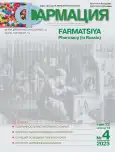Morphological and microscopic features of Prunella vulgaris L. herb
- Authors: Shamilov A.A.1, Bubenchikova V.N.2, Kiseleva O.A.3,4, Garsiya E.R.5, Goncharov M.U.6
-
Affiliations:
- 1Pyatigorsk Medical-Pharmaceutical Institute (PMPI), Branch of Volgograd State Medical University, Ministry of Health of Russia
- Kursk State Medical University (KSMU), Ministry of Health of Russia
- Institute Botanic Garden Ural Branch of Russian Academy of Sciences
- Ural State Medical University, Ministry of Health of Russia
- Pyatigorsk Medical-Pharmaceutical Institute (PMPI), Branch of Volgograd State Medical University, Ministry of Health of Russia
- St. Petersburg Chemical-Pharmaceutical University, Ministry of Health of Russia
- Issue: Vol 72, No 4 (2023)
- Pages: 30-36
- Section: Pharmaceutical chemistry and pharmacognosy
- URL: https://journals.eco-vector.com/0367-3014/article/view/567941
- DOI: https://doi.org/10.29296/25419218-2023-04-04
- ID: 567941
Cite item
Abstract
Introduction. Authenticity of medicinal plant raw materials implies the conformity of this raw material to the name under which it enters production, in terms of "external signs" and "microscopic signs". These indicators are established for P. vulgaris herb.
Objective: Establishment of the main diagnostic external and microscopic features of Prunella vulgaris L. herb, which should be detected when determining the authenticity of this medicinal plant raw materials.
Material and methods. The study was carried out with air-dry raw materials – Prunella vulgaris herb, collected in the flowering phase – the beginning of fruiting. Various types of optical microscopy were used: light, fluorescent, and stereomicroscopy.
Results. Main diagnostic morphological features of Prunella vulgaris L. are leaf form and leaf edge, degree of pubescence, corolla color which are observed using stereo microscopy. P. vulgaris leafs have ovoid or lanceolate form with whole edge, less often with dentate-crenate edge. The main diagnostic microscopic features are petiolar features such as collateral closed vascular bundles, one central large and two side in the P. vulgaris petiole Autoluminescence of leaf tissue are different.
Conclusion. We detected main morphological and anatomical features of Prunella vulgaris L. herb using optical microscopy: light, luminescent and stereo. We also detected new diagnostic features and clarified the structure of leafs, stems, flowers and seeds. These results may be used for project of pharmacopoeia article «Prunella herb» in the chapter «Autheticity».
Full Text
About the authors
Arnold Alexeevich Shamilov
1Pyatigorsk Medical-Pharmaceutical Institute (PMPI), Branch of Volgograd State Medical University, Ministry of Health of Russia
Author for correspondence.
Email: shamilovxii@yandex.ru
ORCID iD: 0000-0002-6730-9518
PhD in pharmaceutical sciences, associate professor at the Department of Pharmacognosy, Botany and Technology of Phytopreparations
Russian Federation, Kalinina prospect, 11, Pyatigorsk, 357532Valentina Nikolaevna Bubenchikova
Kursk State Medical University (KSMU), Ministry of Health of Russia
Email: bubenhikova.ksmu@yandex.ru
ORCID iD: 0000-0001-9682-0684
professor, PhD in pharmaceutical sciences, Head of Department of Pharmacognosy and Botany
Russian Federation, K. Marx str., 3, Kursk, 305041Olga Anatolievna Kiseleva
Institute Botanic Garden Ural Branch of Russian Academy of Sciences; Ural State Medical University, Ministry of Health of Russia
Email: kiselevaolga@inbox.ru
ORCID iD: 0000-0002-8619-6416
PhD in Biological Sciences, associate professor at the Department of Management and Economics of Pharmacy, Pharmacognosy, senior researcher of Laboratory of Introduction
Russian Federation, 8 Marta str., 202a, Yekaterinburg, 620144; Repinastr., 3, Yekaterinburg, 620028Ekaterina Robertovna Garsiya
Pyatigorsk Medical-Pharmaceutical Institute (PMPI), Branch of Volgograd State Medical University, Ministry of Health of Russia
Email: x-pharm@mail.ru
ORCID iD: 0000-0003-3217-0680
PhD in pharmaceutical sciences, lecturer of the Department of Pharmacognosy
Russian Federation, Kalinina prospect, 11, Pyatigorsk, 357532Mikhail Urievich Goncharov
St. Petersburg Chemical-Pharmaceutical University, Ministry of Health of Russia
Email: mgonch@mail.ru
ORCID iD: 0000-0002-9706-9850
PhD in Biological Sciences, PhD in Pharmaceutical Sciences, associate professor of the Department of Pharmacognosy
Russian Federation, Professora Popova str., 14, Saint-Peterburg, 197376References
- Pisarev D.I., Novikov O.O., Zhilyakova E.T., Abramovich R.A., Bojko N.N. Methodological aspects of private pharmacognostic research. M.: Izdatel'stvo RAMN, 2021; 287 (in Russian)].
- Flora SSSR: v 30 t. T. 20. Genus 1261. Prunella L. Edt. Shishkina B.K., Yuzepchuk S.V. M.: Izd-vo AN SSSR, 1954; 495–9. 555 (in Russian)].
- European Pharmacopoeia Online [Electronic resource]. https://pheur.edqm.eu/home, free (accessed 13.06.2022)
- Shamilov A.A. Plants of the genus Prunella: chemical composition, species pharmacologicalaction. Vestnik VGU, Seriya: Khimiya. Biologiya. Farmatsiya = Proceedings of Voronezh State University. Series: Chemistry. Biology. Pharmacy. 2017; 4: 152–60 (in Russian)].
- Mir R.H., Bhat M.F., Sawhney G., Kumar P., Andrabi N.I., Shaikh M., Mohi-Ud-Din R., Masoodi M.H. Prunella vulgaris L: Critical Pharmacological, Expository Traditional Uses and Extensive Phytochemistry: A Review. Curr. Drug Discov. Technol. 2022; 19 (1): e140122191102. doi: 10.2174/1570163818666210203181542. PMID: 33538676
- Wang S.-J., Wang X.-H., Dai Y.-Y., Ma M.H., Rahman K., Nian H., Zhang H. Prunella vulgaris: A Comprehensive Review of Chemical Constituents, Pharmacological Effects and Clinical Applications. Curr. Pharm. Des. 2019; 25 (3): 359–69. doi: 10.2174/1381612825666190313121608. PMID: 30864498
- Shamilov A.A., Popova N.V., Ivashev M.N. Search of sources of rosemary acid in flora of the North Caucasus. Sovremennye problemy nauki i obrazovaniya = Modern problems of science and education. 2014; 4: 6 (in Russian)].
- The 14th edition of the Russian Federation's State Pharmacopoeia [Electronic resource]. https://femb.ru/record/pharmacopea14?ysclid=l4br7f87r0545047546. (accessed 13.06.2022) (In Russ.)
- Kolosova O.A., Trineeva O.V., Sorokina A.A., Gudkova A.A. Investigation of morphological, anatomical, and diagnostic characteristics of volga setwell (Valeriana wolgensis Kazak) raw material by luminescence microscopy. Farmatsiya = Pharmacy. 2021; 70 (8): 26–30. doi: 10.29296/25419218-2021-08-04 (in Russian)].
- Chistyakova A.S., Sorokina A.A., Dunilin A.D., Gudkova A.A., Bolgov A.S. Assessment of the identity of horse chestnut (Aesculus hippocastanum L.) flowers by microscopic analysis methods. Farmatsiya = Pharmacy. 2021; 70 (7): 32–6. doi: 10.29296/25419218-2021-07-05 (in Russian)].
- Ahmed J.H., Ezer N. Anatomical features of genus Prunella L. growing in Turkey. Turk. J. Pharm. Sci. 2008; 5 (1): 17–27.
- Jehanzeb S., Zafar M., Ahmad M., Sultana S., Zaman W., Ullah F. Comparative petioler anatomy of tribe Mentheae subfamily Nepetoideae, Lamiaceae from Pakistan. Feddes Repertorium. 2020; 131 (3): 163–74. doi: 10.1002/fedr.202000009.
Supplementary files










